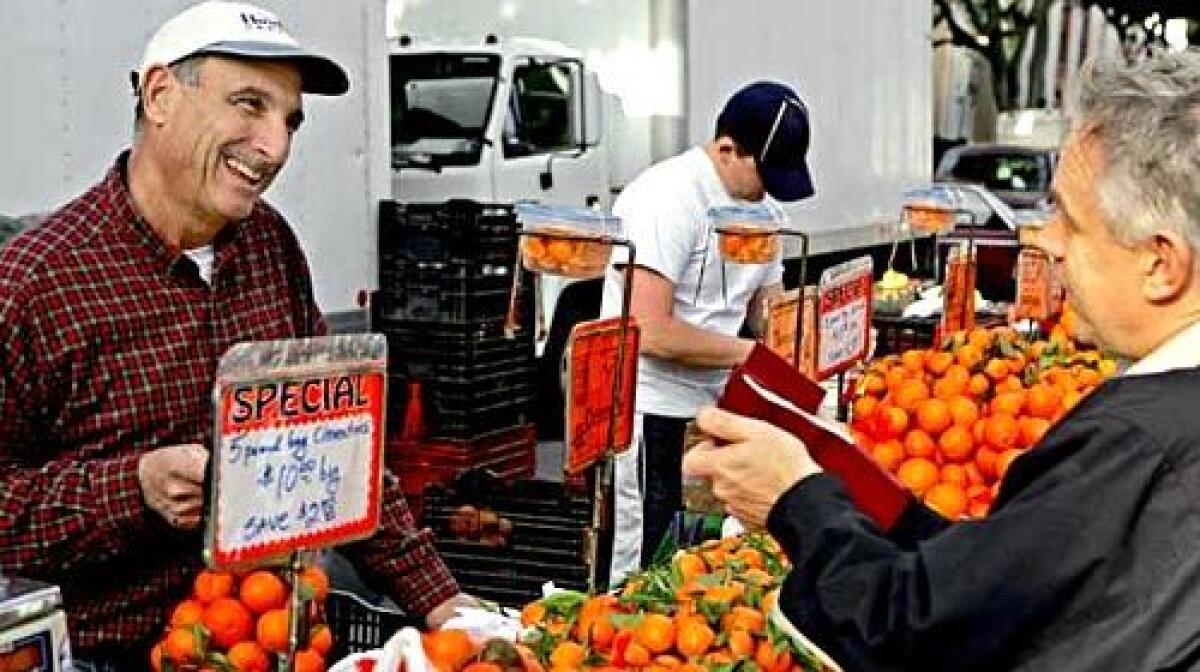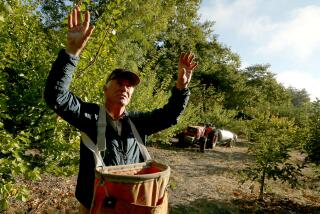This farmer has a zest for experimentation

MEYER LEMONS are so readily available now you can even find them in grocery stores. But back in the day (say, 20 years ago) they were as scarce -- and as sought after -- as Persian mulberries. If you wanted some, you practically had to either have a tree in your backyard or visit Bob Polito at the farmers market.
Polito was one of the adventurous pioneers who, in the 1980s, launched a revolution by helping Southern California cooks discover that there was more to citrus fruit than oranges and grapefruits. Besides Meyer lemons, Polito was one of the first to grow those wonderfully sweet-tart Oroblanco grapefruits, raspberry-tinged blood oranges and candy-flavored Satsuma and Clementine tangerines.
Campanile chef Mark Peel remembers finding the occasional Meyer when he was working at Chez Panisse up in Berkeley and then at early-days Spago, but they were rare. “I don’t know where we were getting them, probably somebody’s backyard,” he says.
“When we opened Campanile and found Polito, that was the first time we could get them on a regular basis. He’s still one of the best guys out there.”
And Polito is still pioneering unusual varieties at the eight Southland farmers markets he works every week. Here is a sampling of what you could buy at his Santa Monica farmers market stand one recent Wednesday morning: Persian, Eureka and Meyer lemons; Oroblancos; Bearss limes; Algerian Clementines, Satsumas, and another mandarin variety he calls “Perfection.” Soon to come are a couple more mandarins and blood oranges.
Oh, yes, there are regular oranges too -- both Valencias and navels.
That’s a lot of variety to pack into the limited amount of land Polito farms among the rolling hills of San Diego County. But making a living at the farmers market -- especially in these trying times -- means offering a healthy mix of delicious discoveries as well as those favorites people already know they want.
Rugged landscape
TO get to the Polito family farm, you wind up into the hills above the town of Valley Center, roughly halfway between Escondido and Mt. Palomar. The landscape is rugged, especially for farm country -- the aptly named Hellhole Canyon park is nearby.
But despite the seeming harshness and aridity, the orchards pressed up against the foothills have been home for decades to some of Southern California’s finest citrus and avocados. Still, today there are probably more new home developments and Indian gaming casinos than orchards -- stark reminders of what awaits farmers who can’t pull their weight financially.
Bob’s father, also named Bob, a retired doctor, and his wife, Rose, bought the home ranch property in the 1960s and still live in the rambling Mission-style house that anchors it, surrounded by succulents and citrus. Bob and his wife, Mary, run the farm and live just up the hill.
The orchards around the house are mature, the trees 15 to 20 feet high and almost outrageously fecund. They are so loaded down with their bright yellow and deep-orange fruit that they look like overburdened Christmas trees.
The real farming began in 1981 when the younger Polito brought his family south and started working the 70-acre home ranch. At the time, it was planted mostly with oranges, Marsh ruby grapefruits and avocados.
It was not an auspicious assortment. “The first thing I realized was that no one wanted the Marsh ruby grapefruit,” he laughs. “They don’t get any color unless they get super hot weather. And we couldn’t sell them. We were always losing money on them.”
Polito is a broad-shouldered, laconic guy who always seems to be wearing a flannel work shirt and baseball cap. He doesn’t seem to get excited by much; one acquaintance describes his style as “farmer phlegmatic.” That’s probably a good thing, given the challenges he’s faced.
Among the original orchards, there were also apple trees, planted in a deep hollow where the cold air collects in the winter. California has never been overly lucky with apples, and particularly not in the southern part of the state. Because they were having such a hard time selling their apples, Rose Polito looked into the then-new phenomenon of farmers markets.
“Mom got in touch with [Santa Monica market manager] Laura Avery, and I went down there to sell some apples,” Polito says. “I just loaded them up in the back of my Chevy LUV pickup truck and drove to Santa Monica. It was pretty funny.”
Though the farmers market wasn’t enough to keep the Politos in the apple business, it was the turning point for the rest of the farm.
At the market, Polito got prices that were much better than what he’d been offered at the commercial packing houses. Even better, he learned a new way to farm.
“There was a farmer at the Santa Monica market that I started talking to from a place called Teepee Ranch out by Lake Elsinore, and she had all sorts of different kinds of fruit,” Polito says. “It looked a lot more interesting than what I had, so I decided I could do that too.”
Teepee Ranch didn’t last long, but another mentor did. In searching for new varieties, Polito found Thermal orchardist Albert Newcomb, a major figure in the California citrus industry in the 1950s and ‘60s. (Newcomb died in 2003 at age 95, but the Willits & Newcomb nursery he founded with his cousin is still going strong.)
“My philosophy was to listen to Albert Newcomb, and if he told me it was good, I put it in,” Polito says. “He knew everything about citrus.
“The first thing I did was graft over 10 acres of those Marsh ruby grapefruit into new varieties -- Star Ruby grapefruit, Oroblanco, Satsumas and Moro blood oranges. That was the start. After that, I started talking to other farmers, and then I got involved with [UC Riverside’s experimental citrus breeding program]. I thought this would be a good place to try some different things,” Polito says.
In went Lane late navels, which stay sweet and juicy clear into July; Meyers; more blood oranges; Lisbon lemons and fragrant sweet lemons; and several kinds of mandarins -- Satsuma and Clementine as well as new University of California varieties Shasta (which he sells as “Primavera”) and Tahoe (which he calls “Tom’s Terrific”), which expand the range of flavors you might expect from the fruit.
There is also another experimental mandarin variety that never got officially released. Polito likes it so much he continues to grow it, calling it “Perfection.”
Long-term commitment
TRYING out new varieties of citrus is not like dabbling in other fruits and vegetables. It takes a tree three to five years to begin bearing salable fruit and five to eight years to reach full production. Then you can usually count on it for at least 30 more years.
“Once you put something in, you’re committed to it,” Polito says. “You can’t just decide to switch over. By the time it’s up and running, that’s 10 years of your life that’s in it. That’s tough to just give up on.”
Besides, it’s enough of a challenge just keeping the farm going these days. These are trying times, particularly in San Diego County. In the last few years, Polito and his neighbors have been visited by a series of disasters that are almost biblical in severity.
First came pestilence: In December 2002, an infestation of the Mexican fruit fly resulted in a quarantine of all citrus grown in the area. For almost 10 months, he couldn’t bring any of his citrus to market. Polito estimates his income took about a 40% hit that year.
“Any reserves we might have had, we lost to the fruit fly,” he says.
Just as the pain from that began to ease, last January’s freeze took many of his avocado trees. Then last summer, the area was scorched by wildfires. Polito lost some citrus -- including a couple rows of sour Seville oranges he was experimenting with.
Most seriously, earlier this month, Polito and other growers in the area had to cut back on their water use by almost one-third. For years they had benefited from a program that gave them reduced water bills in exchange for the promise that they’d be the first to cut back in hard times.
Coping with that might be hardest of all. Avocado growers in the area are “stumping” their groves -- cutting down the trees to shoulder height and withholding water, hoping that by the time the new growth is finally ready to bear fruit, the water crisis will be over.
Citrus growers are in a more difficult position, Polito says. “Citrus prices typically are so bad that there’s no room for games. Avocado growers can afford to stump and wait the situation out, but citrus growers can’t.”
As a result, Polito is planning on cutting down 1,000 of his Valencia orange trees. That’s the summer orange that is used mainly for juicing.
All of which just makes him even more glad he found farmers markets. “If you’re a small grower and don’t use farmers markets, you just can’t make it,” he says.
“Growing oranges just does not work financially otherwise. It’s super expensive to turn California water into orange juice.”
Polito Family Farms is at these farmers markets: Coronado (San Diego County), Tuesday afternoon; Santa Monica, Wednesday; La Cienega, Thursday; Westwood Veterans Affairs, Thursday afternoon; Venice, Friday; Corona del Mar (Orange County), Saturday; Pacific Beach (San Diego County), Saturday; West Los Angeles, Sunday.
More to Read
Sign up for our L.A. Times Plants newsletter
At the start of each month, get a roundup of upcoming plant-related activities and events in Southern California, along with links to tips and articles you may have missed.
You may occasionally receive promotional content from the Los Angeles Times.







